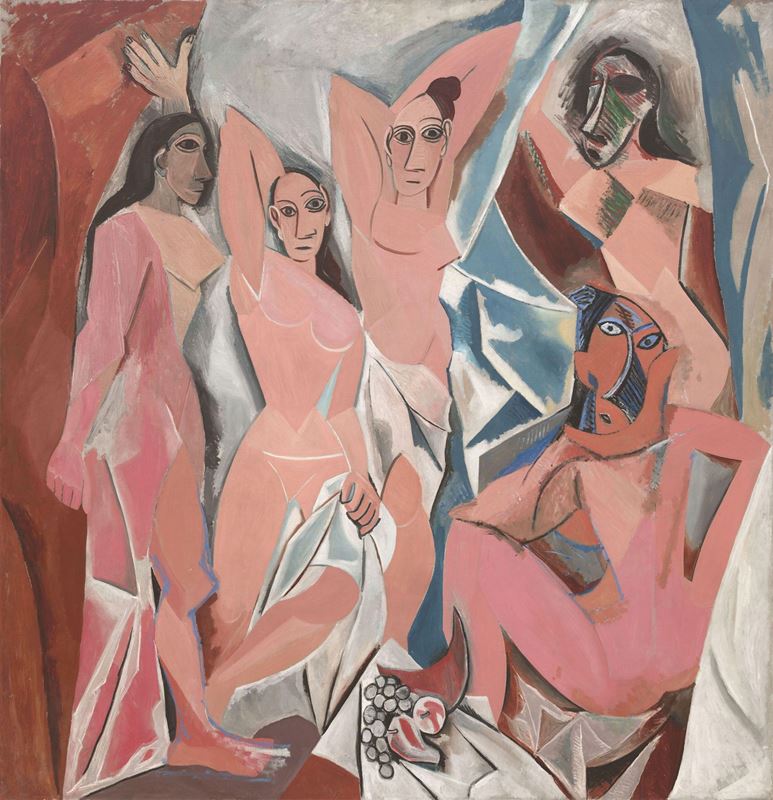The Girls of Avignon - Pablo Picasso
The Girls of Avignon, 1907, Oil on canvas, 243.9 x 233.7 cm, Museum of Modern Art, New York, USA.
In 1907, Pablo Picasso exhibited the first Cubist painting, "The Girls of Avignon". The subject of the painting, which depicts prostitutes working in a brothel in Barcelona, was as unusual and radical as its style. Many critics, poets and artists who had seen "The girls of Avignon" painting for the first time had denied the painting. Georges Braque, who had just met with a Picasso fan, Guillame Apollinaire and Picasso, agreed with the critics for the painting. It wasn't the chosen topic that shocked the elite group. It was the wording style. All the figures were angular and coarse. The bodies and background were degrade to geometric forms. This work coincided with a period when Picasso was interested in Iberian and African sculptures. This work coincided a period when Picasso's interest in the Iberian Peninsula and African sculptures. In Picasso's "Avignon Girls" table, geometric abstraction was combined with mask-like faces that reflected this interest.
The table included five large-body and nude five women. The muscular female figure in the left corner of the painting was immobile and dull, and looked like a statue with a masked face. This figure made the group of women visible by pulling the red curtain at the back and standing as a guard on the side of the stage. There were two other women at the center of the composition. Women's arms were up and displayed their nudity and sexuality. The gaze of the female figures looked directly at the viewer outside the frame. With their warm monochrome bodies, these two female figures had a softer and more realistic face than the others. The other figures seemed to have been shattered by an ax. These two female figures, which attracted attention by their ears and had wide eyes, were influenced by the sculptures in the Iberian Peninsula.
The most striking element in the picture is the distortion of the faces of the two women on the right. Both figures have a mask similar to African masks, which look different from human beings. The fact that these two figures were made with a cubist style led them to come to the fore. The head of the female figure kneeling in front has the most cubist appearance. It is almost impossible to discern where this woman rests her arms. His torso and head were completely different, his back and face all at the same time, and his eyes and mouth subverted the rules of nature. This modification of the human anatomy, the appearance of the anterior and posterior views at the same time, was indicative of the cubist approach. There was another woman entering the room by opening a blue curtain behind this figure. The face of this figure was divided into red and green parallel lines and the body was divided into disproportionate parts.
Picasso had published numerous sketches for this painting, and as he worked on it, painting began to change. At the beginning, the painting was designed as a brothel scene and there were two male figures, a sailor and a student with a naked woman. More women had drawn to the Picasso seaman and the student. But in the final picture, all the harmony originally designed was destroyed, the area was fragmented by geometric faces.
After the exhibition of the "The girls of Avignon" table, the criticism was reduced. Even, his friends began to adapt Picasso's new principles to his paintings. In this way Cubism was born, and painters located next to Picasso were slowly multiplying. Georges Braque, in particular, was Picasso's closest supporter in the development of this new art. After Picasso created new radical forms with the jarring "The girls of Avignon" painting , cubism had become an adventure with Braque and Picasso, who had begun to adopt and used it shortly. Thanks to their close artistic collaboration, they had developed a completely new narrative language. Both painters were influenced by they were influenced by straight and abstract late works of Paul Cézanne, one of the French post-impressionists.
Picasso was a master in terms of drawing technique. He refused to articulate nature in a masterful way. The revolutionary "The girls of Avignon", who has deeply shaken all his contemporaries, is modeled at the climax of this rejection as a model. The painting, which also represents the peak of Picasso's power in expressionism, is now regarded as one of the masterpieces of modern art and it is argued by critics that it influenced the art of the 20th century.
Bibliography;
Walther, I.F., (2005). Picasso, Birinci Basım, Taschen/Remzi Kitabevi, İstanbul.
Buchholz, E.L. ve Zimmermann, B., (2011). Picasso, Literatür Yayıncılık, İstanbul.
Spence, D., (2012). Büyük Ressamlar Picasso, İkinci Basım, Koleksiyon Yayıncılık, İstanbul.
Farthing, S., (2014). Sanatın Tüm Öyküsü, İkinci Baskı, Hayalperest Yayınevi, İstanbul.
Lunday, E., (2013). Büyük Sanatçıların Gizli Hayatları, Beşinci Baskı, Domingo Yayınevi, İstanbul.
Güvemli, S., (2005). Sanat Tarihi, Dördüncü Baskı, Varlık Yayınları, İstanbul.
Bell, J., (2009). Sanatın Yeni Tarihi, Birinci Baskı, NTV Yayınları, İstanbul.
Çev:Öztürk, Ş., (2015). Picasso, İkinci Baskı, Yapı Kredi Yayınları, İstanbul.













